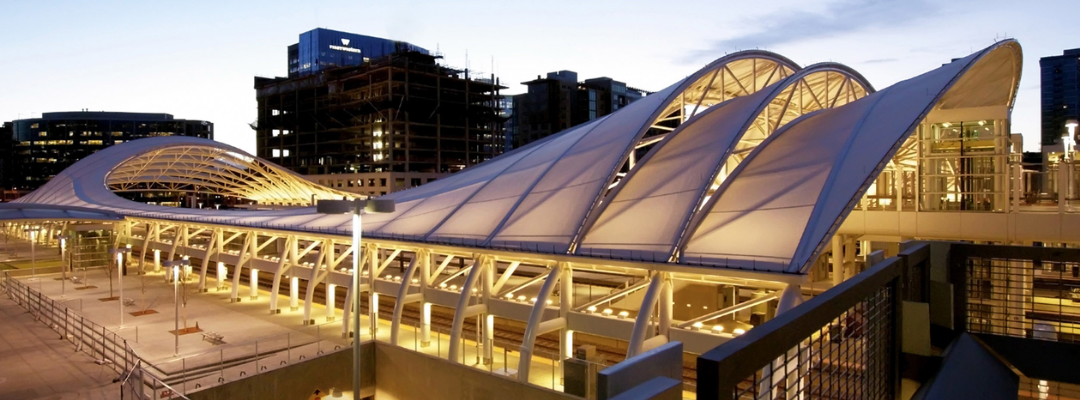Tensile structures have captivated architects and engineers for their innovative design and ability to merge form and function. These lightweight, flexible, and visually striking structures have been used to create some of the most iconic architectural masterpieces worldwide.
1. The Denver International Airport Canopy (USA)
- Year Completed: 1995
- Key Features:
- A striking white tensile roof designed to resemble the Rocky Mountains.
- Made of Teflon-coated fiberglass fabric, it provides natural light while offering protection from the elements.
- Significance:
- A prime example of how tensile structures can combine functionality with aesthetic appeal in large public spaces.
2. The Millennium Dome (London, UK)
- Year Completed: 1999
- Key Features:
- One of the largest tensile structures in the world, spanning 365 meters in diameter.
- Supported by 12 steel masts, symbolizing the months of the year and hours on a clock face.
- Made of PTFE-coated fiberglass fabric.
- Significance:
- A landmark structure showcasing the potential of tensile systems for large-scale cultural and entertainment venues.
3. The Burj Al Arab Helipad and Canopy (Dubai, UAE)
- Year Completed: 1999
- Key Features:
- A luxurious tensile canopy covering the helipad of the iconic Burj Al Arab hotel.
- Designed to withstand high wind loads and provide shade in extreme heat.
- Significance:
- Highlights the use of tensile structures in high-end, visually dramatic architectural projects.
4. The Olympiastadion Roof (Munich, Germany)
- Year Completed: 1972
- Key Features:
- An innovative tensile cable-net roof covering parts of the stadium and surrounding facilities.
- Made of acrylic glass, it combines transparency and strength.
- Significance:
- A pioneering example of tensile architecture, inspiring future designs for sports arenas worldwide.
5. The Eden Project Biomes (Cornwall, UK)
- Year Completed: 2001
- Key Features:
- Geodesic dome structures covered with ETFE (Ethylene Tetrafluoroethylene) tensile membranes.
- Houses the world’s largest indoor rainforest.
- Significance:
- Demonstrates how tensile structures can be used for sustainable and eco-friendly architectural projects.
6. The Allianz Arena Facade (Munich, Germany)
- Year Completed: 2005
- Key Features:
- A facade made of ETFE cushions that can be illuminated in different colors.
- Provides a lightweight, weather-resistant covering for the stadium.
- Significance:
- Illustrates the potential of tensile materials for dynamic and energy-efficient architectural designs.
7. The Sheikh Zayed Cricket Stadium Canopy (Abu Dhabi, UAE)
- Year Completed: 2004
- Key Features:
- Tensile canopies provide shade for spectators while maintaining an open-air design.
- Made of PTFE-coated fiberglass fabric.
- Significance:
- A practical yet elegant solution for enhancing comfort in hot climates.
8. The Khan Shatyr Entertainment Center (Astana, Kazakhstan)
- Year Completed: 2010
- Key Features:
- A 150-meter-high tensile structure made of ETFE, creating a climate-controlled environment.
- Spans 140,000 square meters, housing shops, restaurants, and recreational areas.
- Significance:
- One of the largest tensile structures in the world, showcasing the versatility of ETFE.
9. The O2 Arena (London, UK)
- Year Completed: 2007
- Key Features:
- Formerly known as the Millennium Dome, it was transformed into a world-class entertainment venue.
- Features a tensile fabric roof supported by steel masts.
- Significance:
- A testament to the adaptability and durability of tensile structures over time.
10. The Ferrari World Roof (Abu Dhabi, UAE)
- Year Completed: 2010
- Key Features:
- The world’s largest tensile roof structure, covering 200,000 square meters.
- Made of metal and fabric membranes, designed to resemble a Ferrari hood.
- Significance:
- Combines brand identity with cutting-edge architectural design.
11. The Sony Center Roof (Berlin, Germany)
- Year Completed: 2000
- Key Features:
- A steel and fabric tensile structure inspired by Mount Fuji.
- Features a translucent roof that lights up in vibrant colors at night.
- Significance:
- Highlights the use of tensile systems to create dynamic, multifunctional public spaces.
12. The Hyderabad International Convention Centre (India)
- Year Completed: 2006
- Key Features:
- A tensile roof made of PTFE-coated fiberglass, providing shading and ventilation.
- Covers a vast area used for exhibitions, conferences, and events.
- Significance:
- Showcases the use of tensile structures in large-scale event venues in India.

